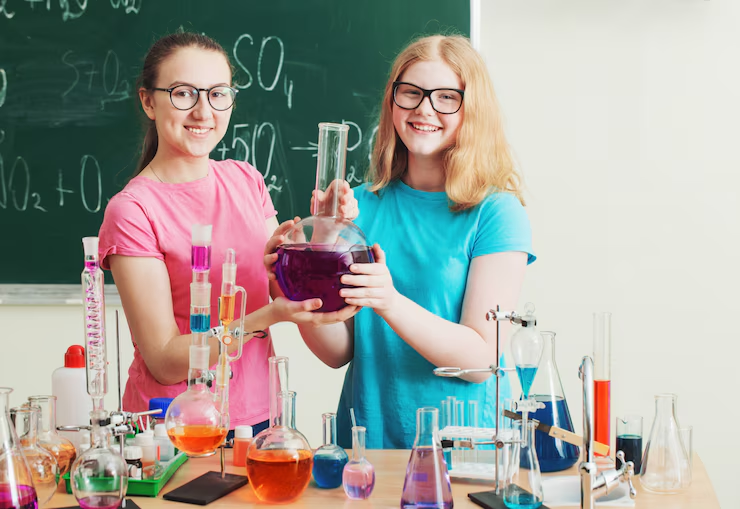What do you know about enzymes? If you can’t remember much, it’s time to refresh your knowledge (or gain it) with this AP Biology crash course. To be honest, it isn’t the hardest topic. Still, there are a lot of specific definitions you should know if you are going to take the AP Biology exam.
In this blog, we’ve gathered all the basics you should learn about enzymes’ structure, activity, characteristics, types, and functions. So, join us in this enzymatic journey and master one more biology topic!
AP Biology Exam: Cellular Energetics
Source: Freepik
You already understand that knowing how enzymes work is essential to get a good score on the AP Biology exam. Enzymes are fundamental for one of the 8 units of the AP Biology test called “Cellular Energetics.” It constitutes 12-16% of your final score. These are the topics this unit covers:
- Enzyme structure;
- Enzyme catalysis;
- Environmental impacts on enzyme function;
- Cellular energy;
- Photosynthesis;
- Cellular respiration;
- Fitness.
What Are Enzymes?
Let’s start with the basics – enzyme definition. They are proteins that act as catalysts to speed up chemical reactions in biological systems. Enzymes are vital for the development and homeostasis of animals, plants, microorganisms, and all living organisms. In addition, enzymes play crucial roles in medicine, biotechnology, molecular biology, and other life sciences.
Structure of Enzymes
Source: Alevelnotes
Enzymes are mainly globular proteins that can combine to make multi-enzymatic complexes. Apart from globular proteins, enzymes can also exist in other structural forms (e.g., fibrous proteins). Overall, they are long sequences made with amino acids that make specific globular structures perform particular functions. Different kinds of enzymes are different in size, shape, and molecular mass.
The main peculiarity of the enzyme molecules’ structure is that they have an active site, a region of the enzyme where the substrate binds and the chemical reaction occurs. An active site contains:
- A binding site. The part where the enzyme interacts with its substrate.
- A catalytic site. The part that activates chemical reactions.
Also, enzymes might have allosteric sites. They are specific places where binding of small molecules can cause conformational changes. As a result, their activity might increase or decrease.
Different Types of Enzymes
Source: ResearchGate
Today, science knows many enzymes with different structures and functions. They have their own nomenclature and classification:
- Ligases. They join two different molecules together with covalent bonds.
- Isomerases. They catalyze different isomerization changes with particular molecules.
- Hydrolases. They catalyze the hydrolysis reaction in chemical bonds.
- Lyases. They can cleave chemical bonds.
- Oxidoreductases. They participate in oxidation or reduction reactions.
- Transferases. They can transfer the functional groups from one molecule to another.
- Translocases. They catalyze transmembrane molecular movements.
Functions of Enzymes
Enzymes are often classified by their main functions. What are the main functions of enzymatic proteins?
- Signaling. They play critical roles in cellular signaling pathways by modifying proteins or other molecules in response to various stimuli (a common example is protein kinase).
- Regulatory. These enzymes control the rate of metabolic reactions by modulating the activity of other enzymes (phosphotransferases).
- Metabolitic. They are involved in the biochemical reactions that occur within cells, including glycolysis, the citric acid cycle, and the electron transport chain (glycolytic or citric acid cycle enzymes).
- Catabolic. These enzymes catalyze reactions that break down large molecules into smaller ones, releasing energy in the process (lipases, proteases, cellulases, and digestive enzymes).
- Defense. They help protect cells from damage caused by reactive oxygen species (catalase or superoxide dismutase).
- Detoxification. Enzymes like cytochrome P450s are involved in the metabolism and detoxification of foreign compounds, including drugs and environmental toxins.
SAT studying with cutting-edge tech
Prep for the PSAT, SAT, or ACT with Acely, our AI powered test prep tool. Get a personalized study plan, question hints, explanations and performance data to help you reach your test goals.
How Do Enzymes Work?
Numerous types of enzymes have a few things in common:
- They interact with the substrate;
- They speed up chemical reactions.
Mechanism of Enzymatic Activity
Source: OnlineBiologyNotes
What is a substrate? This is a substance that interacts with enzymes. Those can be different molecules. Usually, these substances are smaller in size than their enzymatic proteins.
Each enzyme has an active site with binding and catalytic parts. The active site is unique for each substrate. Simply put, they interact like puzzle pieces. Thus, the common mechanism of enzyme activity has the following steps:
- Substrate enters the active site;
- Substrate and enzyme make a single complex;
- Enzymes activate their catalytic activity;
- Product appears after catalysis;
- Enzymes and products make a complex;
- The product leaves the active site.
That’s what you need to know about the basic mechanisms of enzymatic activity, which is pretty common for different types of enzymes. At the beginning of the reaction, we have a substrate, but at the end, we get the product. Simply put, a product is a substrate that gets some modifications after interacting with enzymes. Meanwhile, this product can act as a substrate for other enzymatic proteins.
What Is Enzyme Catalysis?
Enzymatic catalysis is a fundamental biological process in which enzymes accelerate chemical reactions. This process involves the binding of substrate molecules to the active site of the enzyme. As a result, conformational changes stabilize the reaction’s transition state, leading to the catalysis of the substrate into a product.
Enzymes exhibit high specificity for their substrates. They recognize and bind only to molecules with particular chemical structures. Thus, enzymatic catalysis offers the following advantages: specificity, efficiency, regulation, and reversibility. It plays critical roles in metabolism, DNA replication, protein synthesis, signal transduction, and many other processes covered in Cellular Biology.
Thermodynamics of the Enzymatic Process
The thermodynamics of the enzymatic process is how enzymes affect a reaction’s free energy change (?G). It determines whether a reaction is spontaneous or non-spontaneous:
- Gibbs free energy (?G). It represents the change in free energy during a chemical reaction. It determines whether the reaction will proceed spontaneously (?G < 0), proceed non-spontaneously (?G > 0), or be at equilibrium (?G = 0).
- Activation energy (Ea). The activation energy is the barrier that must be overcome for a reaction. Enzymes lower the activation energy barrier, making the reactions proceed easier.
- Transition state. Enzymes stabilize the reaction’s transition state, lowering the activation energy required for the reaction. This is an essential aspect of enzymatic catalysis.
- Equilibrium constant (K). Enzymes do not alter a reaction’s equilibrium constant (K). This is the difference in free energy between the reactants and products. Yet, enzymes can speed up the attainment of equilibrium.
- Enzyme-substrate binding. The binding of substrate molecules to the enzyme’s active site is essential in enzymatic catalysis. The formation of the enzyme-substrate complex involves hydrogen bonds, electrostatic interactions, and van der Waals forces.
What Are Cofactors and Coenzymes?
Source: BestBioChemistry
Sometimes, enzymes need extra help to activate themselves. And here, you have to remember two major terms: cofactors and coenzymes. What do they do, and what is the difference? Let’s figure out.
- Cofactors are compounds (ions, small molecules) that interact with enzymes and increase their activity. How? During such an interaction, they change the enzyme’s conformation. As a result, it might open binding sites for the substrate. Examples of cofactors include metal ions like Fe2+ in the heme group of cytochrome c and Zn2+ in the active site of carbonic anhydrase.
Cofactors are essential for the activity of certain enzymes, particularly those that require metal ions for catalytic function. Besides, cofactors can either activate enzymes or serve as prosthetic groups that are permanently bound to the enzyme.
- Meanwhile, coenzymes are small, organic molecules bound to enzymes. They participate in enzyme-catalyzed reactions by donating or accepting chemical groups. Usually, coenzymes are vitamins or other dietary sources. They often contain reactive functional groups. Coenzymes bind temporarily to the enzyme’s active site or other specific sites. Thus, they can leave it after the reaction happens. Examples of coenzymes include NAD+ (nicotinamide adenine dinucleotide) and FAD (flavin adenine dinucleotide).
Thus, enzymatic proteins have two forms:
- Apoenzyme is a protein part only;
- Holoenzyme is a protein part with non-protein (ions, other molecules).
Inhibition Process
Source: Toppr
Inhibition is the process that reduces or stops the activity of an enzyme. There are several types of inhibition:
- Competitive inhibition;
- Non-competitive inhibition;
- Uncompetitive inhibition;
- Mixed inhibition.
In competitive inhibition, the inhibitor molecule competes with the substrate for binding to the enzyme’s active site. Since both the substrate and inhibitor can’t bind to the active site simultaneously, only one can win this game. For example, many drugs function as competitive inhibitors. They mimic the structure of the substrate and bind to the active site.
In non-competitive inhibition, the inhibitor binds to a site on the enzyme other than the active site, known as the allosteric site. This binding changes the shape of the enzyme, reducing its catalytic activity. For example, heavy metal ions like mercury can act as non-competitive inhibitors. They bind to specific amino acid residues on the enzyme.
Uncompetitive inhibition occurs when the inhibitor binds only to the enzyme-substrate complex, not the free enzyme. This stabilizes the complex and prevents the release of the product.
Mixed inhibition involves the inhibitor binding to either the enzyme or the enzyme-substrate complex, but with different affinities. Some toxins and metabolic byproducts can act this way.
What Factors Affect Enzymatic Activity?
Source: pubsrscorg
There are a few factors that can influence enzymatic activity. Let’s review them:
- Substrate concentration. Increase in the substrate concentration usually speeds up the rate of enzyme-catalyzed reactions. This lasts until saturation when there are no free enzyme active sites left.
- Enzyme concentration. Higher rates typically lead to an increased reaction, assuming substrate concentration is not limiting.
- Acidity (pH). Enzymes have optimal pH ranges where they exhibit the most activity. Deviations from this range can denature enzymes or alter their active site conformation, reducing activity.
- Temperature. Enzymatic proteins have optimal temperature ranges for activity. Increasing temperature levels up reaction rates. This is possible due to higher molecular motion. Still, the enzyme denatures at extreme temperatures.
- Cofactors and coenzymes. Their absence can impair enzymatic function.
- Inhibitors. Various molecules can inhibit enzyme activity. They bind to it and reduce its functionality.
- Enzyme structure. Changes in enzyme structure, such as mutations or modifications, can affect enzyme activity.
- Ionic strength. Changes in ionic strength, influenced by the concentration of ions in the solution, can affect enzyme activity. This alters protein stability or interactions between enzyme and substrate.
- Substrate specificity. Enzymes exhibit specificity for particular substrates. Changes in substrate structure can affect enzyme-substrate interactions and, so, activity.
Conclusion
That’s it! We hope enzymes don’t seem that complicated to you after checking this guide. Now, you know their structure, types, main characteristics, and functions. Of course, molecular biology might be complicated at first, but the more you practice, the easier it gets. Review the prep literature, take extra online courses, consider learning Biology with a tutor, move at your own pace, and be consistent. This way, you will definitely nail your exam. Good luck!





